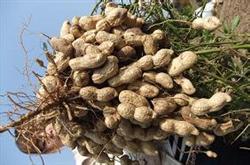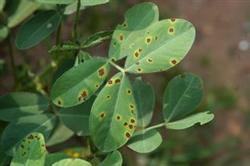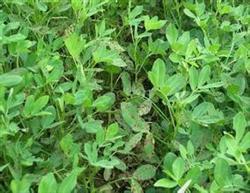Key Techniques for High-yielding Cultivation of Peanut

The planting area of peanuts in China is about 70 million mu, accounting for 1x3 of the national oil area, and the total output is 48% of the country's total oil output, ranking first among oil crops. With the continuous innovation of cultivation techniques and the breeding and popularization of early-maturing varieties, the peanut farming system has developed from one-year to multi-year, from single to intercropping, and the rotation in the main producing areas is also changing. Due to the differences in topography, precipitation and temperature, peanut planting methods are divided into three types, including flat planting in flat land, ridge cultivation after deep loosening and soil preparation, and border cultivation which is conducive to drainage. Ridge cultivation is divided into single-row ridge cultivation and double-row ridge cultivation. The technical link of peanut cultivation peanut soil requirements: the first is not continuous cropping, otherwise it will cause diseases and insect pests and peanut root self-poisoning. The second is that the pH value of the soil should be between 6 and 7, and the soil should be loose, breathable, sandy and solid. The third is the need to contain organic matter and adequate calcitonin. After soil conditions are available, seeds should be dried, shelled and graded before sowing. In order to reduce rotten seeds and diseases, seed dressing with carbendazim and micro-fertilizer should be used to improve the germination rate and emergence rate of seeds. Due to geographical differences, the most suitable sowing time in the north is from late April to early May, the sowing time in the middle and lower reaches of the Yangtze River is around the Qingming Festival Grain Rain, and summer peanuts can be sowed 25-30 days before harvest, while plastic film mulching cultivation is 10-15 days earlier than open field cultivation. In the way of sowing, there are mainly manual sowing, mechanical sowing, iron stubble sowing and so on. The requirement for mechanical sowing is that the sowing depth is about 5cm, and the land with low ground temperature or high soil moisture can be sowed lightly, but the shallowest should not be less than 3cm, otherwise it can be deepened appropriately, but not more than 6cm. The main problems of machine sowing are unstable operation quality, large proportion of lack of holes, lack of grains and three holes, inconsistent sowing depth and uneven row spacing. Therefore, in order to solve the defects of machine sowing operation, we should first improve the quality of soil preparation, and then control the amount of machine fertilization, select seeds and control the distance between ridges. The nutrient requirement of peanut is characterized by strong barren tolerance, considerable yield can be obtained by using a small amount of fertilizer, and the absorption of main nutrient elements is nitrogen > potassium > phosphorus > calcium. Peanut absorbs less fertilizer at seedling stage, increases gradually at flowering stage, reaches the maximum at podding stage, and decreases at mature stage. The specific principles of peanut fertilization are as follows: first, organic fertilizer is given priority to, supplemented by chemical fertilizer; second, base fertilizer is given priority to, topdressing is supplemented by fertilizer seedlings, flower fertilizer and strong fruit fertilizer; fourth, nitrogen, phosphorus and potassium are used together. The main technical measures for peanut field management are as follows: first, check the seedling gap, 10-15 days after sowing in spring peanut and 7-8 days after sowing in summer. Second, it is necessary to clear the squatting seedlings, which means that after the peanut seedlings are completed, the topsoil around the seedlings is removed to expose the lateral branches between the two cotyledons and the axils of cotyledons, so as to facilitate the healthy growth of the first pair of lateral branches and seedlings. Third, weeding in the middle ploughing requires that "the first is shallow, the second is deep, and the third does not hurt the roots." Fourth, insect pests should be prevented. In the process of peanut planting, plastic film mulching can increase production by more than 35%, and the high yield can reach 70%. The advantages are: increasing soil temperature, preserving soil moisture, enhancing drought and waterlogging resistance, keeping soil loose, reducing fertilizer loss, and so on. Conventional polyethylene mulch film is often selected with a width of 90cm and a thickness of no less than 0.004mm. Main points of peanut interplanting cultivation interplanting peanut with wheat row is a cultivation method which aims to improve the multiple cropping index and make full use of soil fertility and light energy resources. The main technical points of wheat row interplanting are as follows: one is to reserve peanut rows on the basis of wheat specification sowing. Double-row interplanting can open the box for 0.8 meters, sow two rows of wheat in each box, and set aside 0.5 meters to sow two rows of peanuts. The second is to select improved varieties and sow early at the right time. Wheat should choose high-yield and high-quality varieties with early maturity, short stalk and not easy lodging, while peanuts should choose high-yield varieties with early maturity, compact plants and strong shade tolerance. Generally, it is appropriate to sow 25-30 days before wheat harvest, and the symbiotic period of peanut seedlings and wheat is controlled at 15-20 days. The third is reasonable fertilizer application, because the early growth of wheat interplanting peanut is covertly affected by wheat, so under the premise of applying sufficient base fertilizer when sowing wheat, early application and skillful topdressing according to peanut seedling condition is the key to obtain high yield of peanut. After the peanut seedlings are complete, the seedlings can be extracted with 7-8 kg urea per mu, and 0.2% potassium dihydrogen phosphate can be used as foliar topdressing 1-2 times at full flowering.
- Prev

Measures of "three Prevention" to promote yield increase in the later stage of Peanut
What is the difference between peanut black spot and brown spot? Peanut black spot and brown spot are the most common leaf diseases of peanut, which are characterized by the formation of spots on the leaf surface, so they are collectively called leaf spot disease. The main differences are: Brown spot occurs earlier, occurs at the early flowering stage, and the disease spot on the leaves is larger, round or irregular in the later stage.
- Next

How is peanut clump disease caused? How to prevent and cure?
How is peanut clump disease caused? How to prevent and cure? The main results are as follows: (1) incidence regularity: peanut witches' broom disease may be a disease infected by mycoplasma or mycoplasma and virus. Neither seed nor soil can transmit disease, but grafting can infect it. Whether other insects and juices can transmit poison is being studied. The occurrence of arbuscular disease of peanut.
Related
- The first cup of black tea in spring, the flavor and history of tea gardens in Kenya, Africa
- The computer can not only choose potatoes, but also grow tea rice. AI will grow winter oolong tea champion.
- It is not only the inflated tea bitten by insects, but also engraved with the four seasons tea in Beipu.
- The Oriental Beauty Tea Festival in Zhuxian County takes the stage at the weekend to experience the plus-size feast of oil tea.
- & quot; Oriental Beauty Tea & Exploration of Emei in Hsinchu, the hometown of quot;
- The new variety of strawberry "Tainong 1" dessert is the first choice with mellow aroma. Crimson gorgeous
- History of Tea in Taiwan: from Wild Inner Mountain to Export Tea Garden
- Two types of Taiwan Oriental Beauty Black Tea won the British three-Star Award for Childhood Tea Xiang Zhang Jiaqi changed from pilot to champion tea maker.
- Banana species and varieties: the planting history of Taiwan Xianren banana and dwarf banana is long, is banana disease resistant?
- Coffee planting Technology: Qianjie Coffee from Seedling to harvesting

